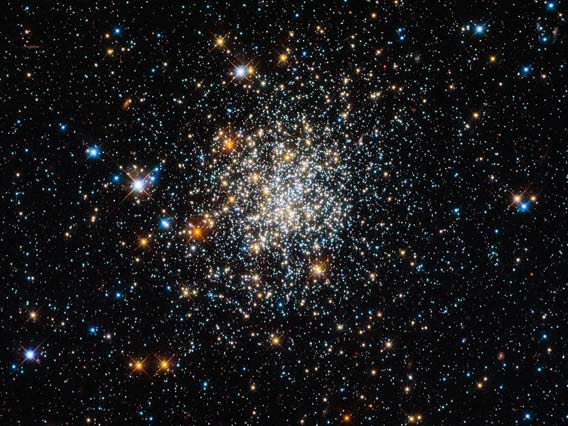Create a free profile to get unlimited access to exclusive videos, sweepstakes, and more!
A Sparkling Imposter

I love star clusters. Theyâre crucial to our understanding of the way stars form, live, and dieâstars change as they age, making it hard to compare one to another if they are vastly different ages. But the stars in a cluster are all born at the same time, so that makes it a lot easier to understand their behavior. Itâs like having them in a lab for study.
There are two kinds of clusters: globular clusters (old, roughly spherical, and densely packed), and open clusters (younger, shapeless, and with stars scattered throughout). Iâve seen both kinds many, many times in photos as well as with my own eyes; theyâre a favorite target of mine when Iâm using a small telescope.
Which is why this Hubble picture of NGC 411 really threw me for a moment. What kind of cluster is it?
I thought it was a globular for a moment. The shape is about right, if a little diffuse. But then I noticed all the blue stars. This image is a combination of ultraviolet (shown as blue), visible light (green), and infrared (red). All the globular clusters we know are old, as old as the galaxy itself, about 10-12 billion years. Blue stars are hot, massive, and young: They explode as supernovae after only a few million years. Globular clusters had lots of blue stars when they were young, eons ago, but those stars are long gone. All that remains are yellow, orange, and red stars (though there are exceptions).
NGC 411 has far too many blue stars to be a globular. So itâs an open cluster. In fact, its age can be determined by looking at the colors of the stars in itâbluer stars are more massive and blow up sooner, so by looking at the bluest stars in it, an upper limit to the age can be found. In practice itâs way harder than this, but studies show NGC 411 is about 1.5 billion years old. Thatâs far too young to be a globular, though fairly old for an open cluster.
Then I got my second surprise: NGC 411 isnât even in our galaxy. Itâs in the Small Magellanic Cloud, a dwarf companion galaxy to the Milky Way. That puts it at a distance of about 200,000 light years, far, far more distant than the clusters I peruse with my own âscope.
And thereâs one more thing to notice. In the higher-resolution images (hereâs the 3700 x 2750 pixel version) you can see several small galaxies dotting the sky in the background. Those galaxies are probably hundreds of millions or even billion of light years distant, thousands of times farther away than NGC 411. So think about that: In this picture you can see right through the cluster of stars, and right through its parent galaxy into truly deep space. Youâre seeing those galaxies as they were before dinosaurs walked the Earth, some even before life arose out of our planetâs oceans.
Some objects like NGC 411 might be good at being deceptive about their ages, but whole galaxies? Not so much. The Universe has been around a long, long time. But I have to say: It looks pretty good for its age.














